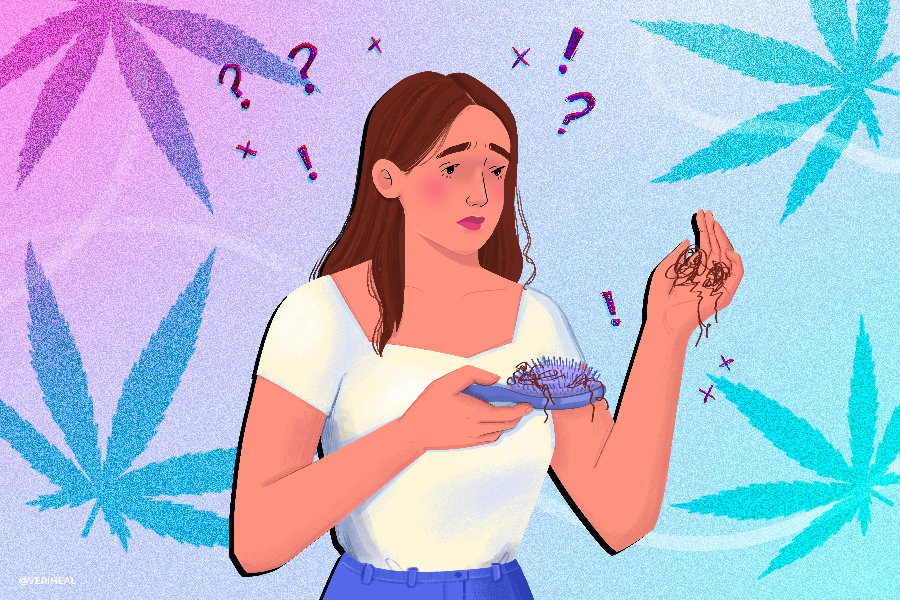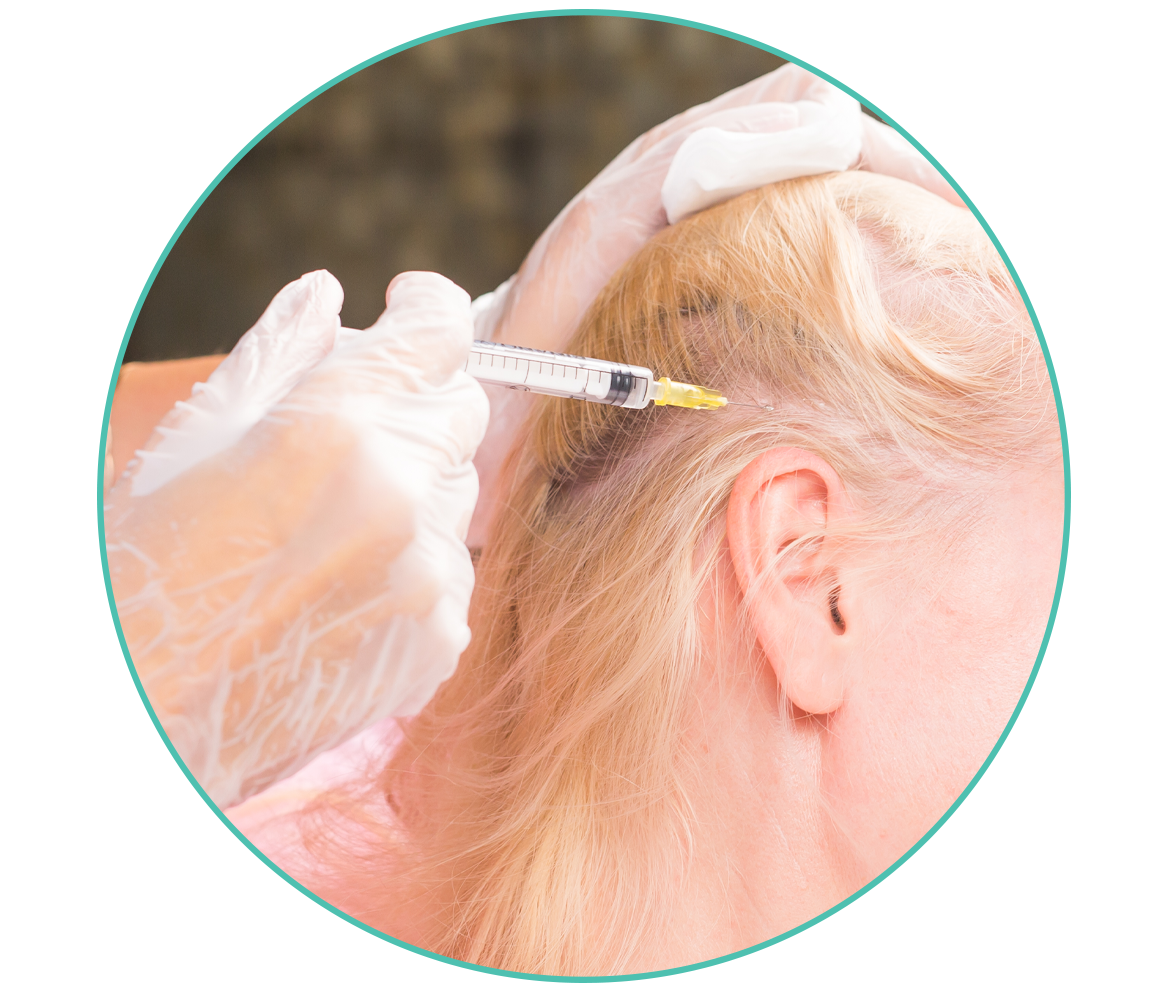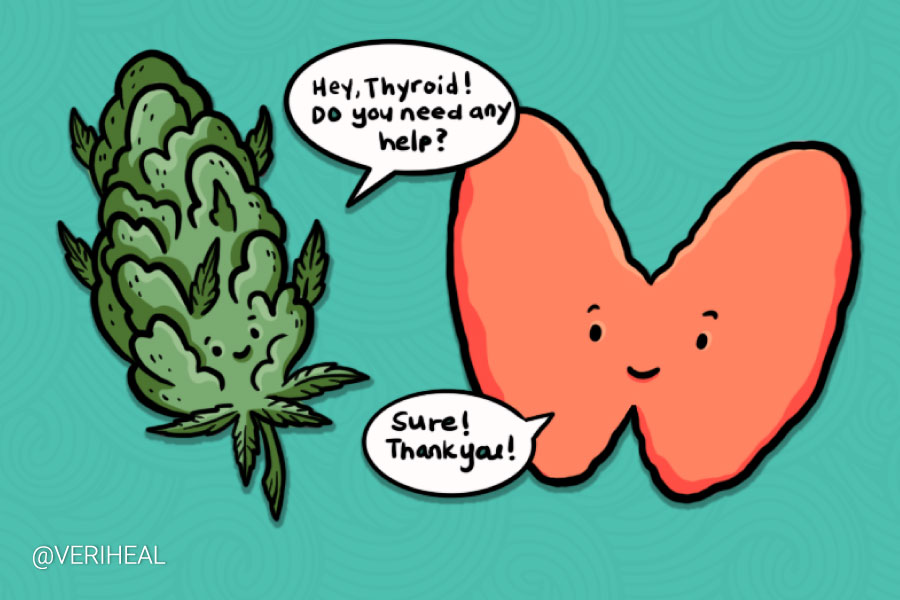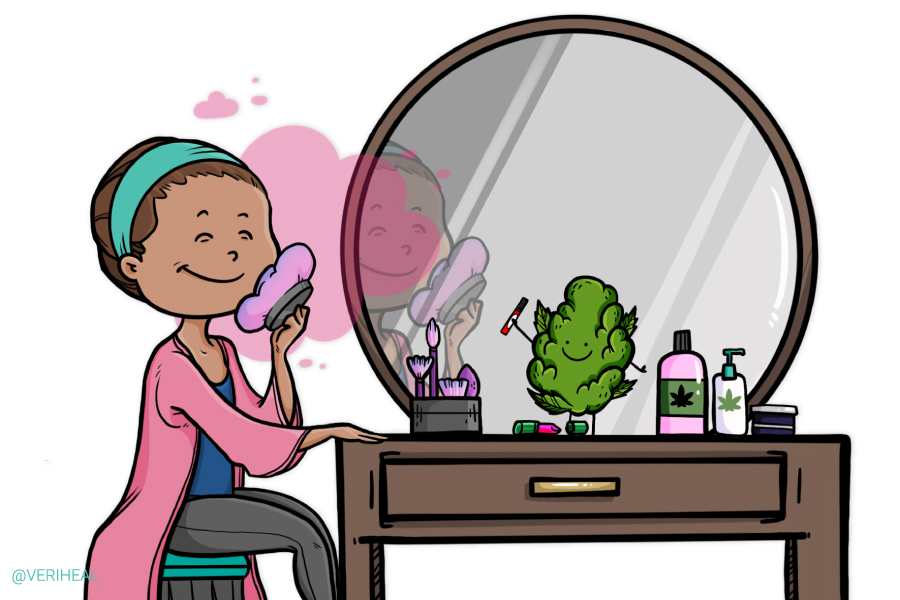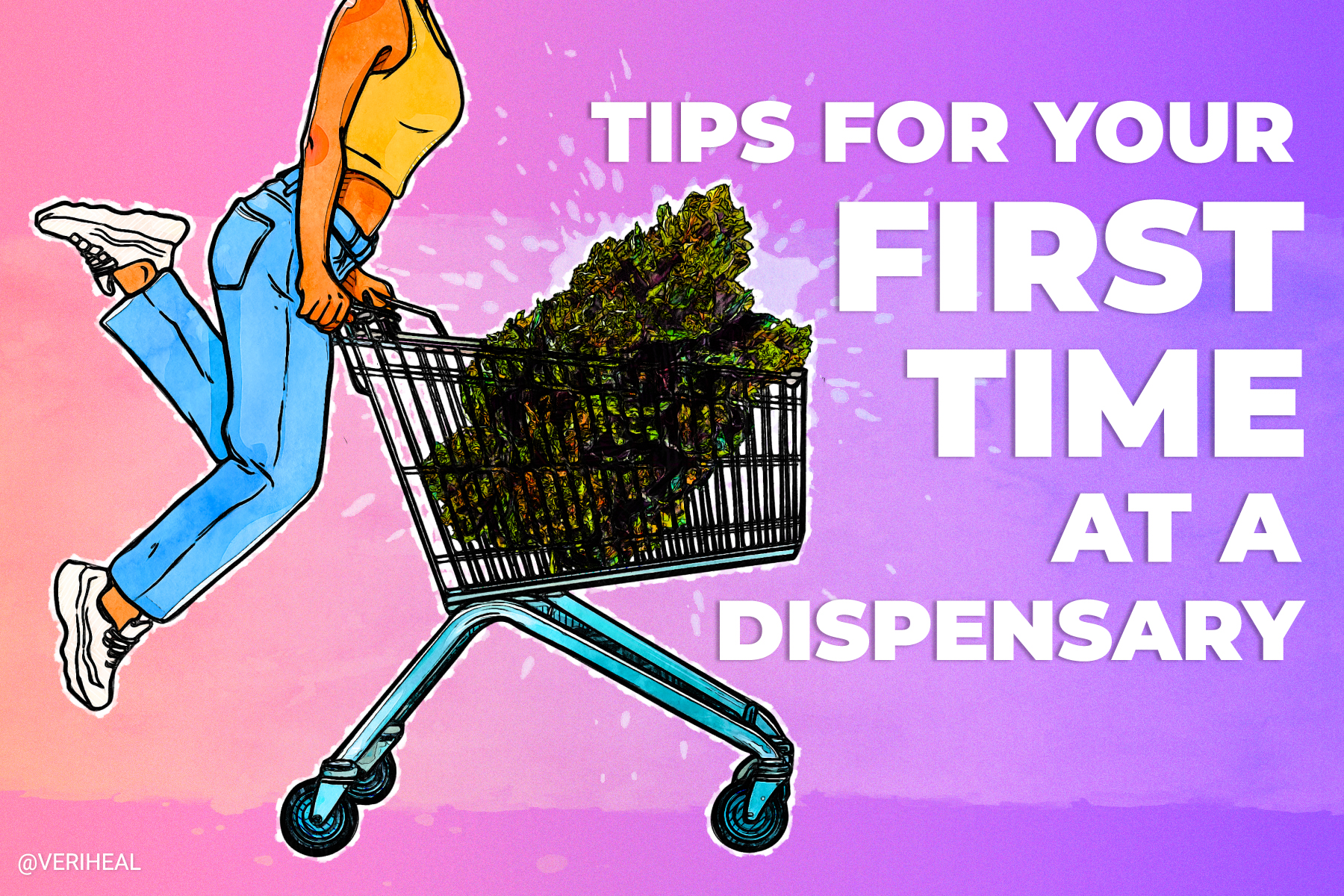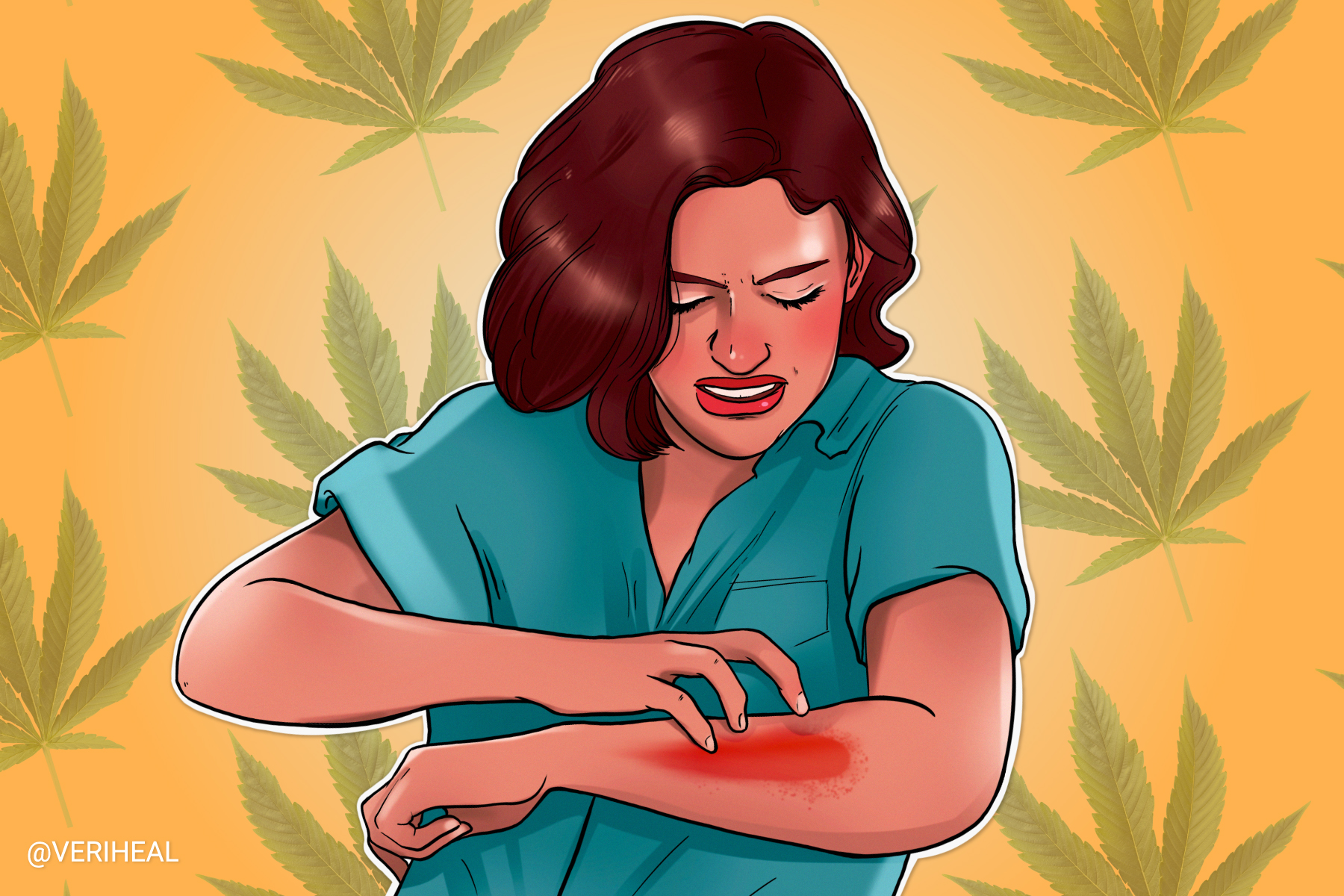Hair Loss from Alopecia Areata | Can Marijuana Help Growth?
- Can Cannabinoids Help Alopecia?
- Thoughts About Cannabis Hair Care
- What is Alopecia Areata?
- Other Causes of Hair Loss
Many people fear losing their hair as they age, but for some people with alopecia areata, this reality can hit quicker. Many doctors are not exactly sure why some people lose patches of hair on the scalp, arms, legs, beard, eyelashes, eyebrows, and other places, but they do believe there is a link to this type of hair loss and autoimmune diseases. For some patients, the hair grows back and never reoccurs, but others suffer permanent hair loss. Along with the symptoms of hair loss, medical cannabis can serve as a good tool in easing anxiety, depression, and other mood disorders that are associated with unwanted changes in appearance and chronic illness.
Medical cannabis and its cannabinoids, including cannabidiol (CBD) and Δ9-tetrahydrocannabinol (THC), begin interacting with our bodies through the endocannabinoid system (ECS). This system in our bodies is made from fat-based neurotransmitters that come into contact with cannabinoid receptors CB1 and CB2. CB1 receptors are commonly found in the central nervous system while CB2 receptors are found in a variety of organs in the body. When these receptors are activated, the body decreases or increases the fatty-based neurotransmitters in the brain. Thus, is why the ECS plays a role in homeostasis, pain perception, inflammation responses, and more in our bodies.
A variety of current research studies now show that the skin and hair follicles contain large amounts of CB1 and CB2 receptors, including keratocytes, which are responsible for producing keratin on the skin and hair as well sebocytes that produce oil (2)(27). In the hair follicle, there are also peroxisome proliferator-activated receptors (PPAR) which are responsible for gene expression as well as transient receptor potential (TRP) receptors which play a role in the growth of hair shafts.
PPAR receptors in the hair can also be targeted through the ECS to reduce inflammation in the hair and on the scalp as well as serve as an analgesic, or pain reliever (2). PPAR and TRP receptors also positively and negatively interact with cannabinoids and can play a role in mediating hair loss (3).
A 2011 study showed that when specific TRP receptors (like TRPV-3), keratinocytes, and sebocytes are activated in hair, it can inhibit hair growth, and increase cell apoptosis or death (3). This is important because hair is grown from dead cells. TRPV receptors in this study also caused premature hair follicle regression. Overall, this study shows that the TRVP receptors in the hair along with keratinocytes and oil-producing sebocytes may be targeted or modulated to help increase or decrease hair growth.
Can Cannabinoids Help Alopecia?
Some research suggests both THC and the endocannabinoid anandamide (AEA) can actually slow hair growth instead of promoting it because they activate CB1 receptors (11). A 2007 study examining cannabinoids used for hair growth shows that dependent on the doses of THC and the amount of AEA released, hair shaft elongation can be slowed through the activation of CB1 receptors (23). Both AEA and THC have been shown to also shut down melanogenesis in hair follicles. Melanogenesis is the process in which melanin is produced in the hair.
Alternatively, CB2 receptors, which are primarily activated by CBD as opposed to THC, are not present in hair follicles. However, CBD, cannabidivarin (CBDV), and tetrahydrocannabivarin (THCV) are antagonists to CB1 which may then promote hair growth by acting opposite to THC and CB1 agonists. Another major endocannabinoid called 2-Arachidonoylglycerol (2-AG) has been shown to have no negative effect on the hair shaft (23).
Certain studies available also support the use of CBD for alopecia. A small study published in 2021 focused on treating 35 patients with androgenetic alopecia (AGA), which is caused by too much dihydrotestosterone in hair follicles. This study examined the use of topical hemp oil containing 3-4 mg per day of CBD that had minimal amounts of other cannabinoids (21). Measurements were taken before and after six months of treatment and showed a 93.5% average increase in hair growth on the vertex, or top of the head and in the temporal areas of the scalp.
What’s interesting is that men had a better success rate of hair growth on the top of the head as opposed to female participants. According to this study, CBD works through different mechanisms as opposed to other hair loss treatments and medications such as finasteride and minoxidil and would be safe to use in addition to these medications (21).
Another study focusing on the topical use of CBD shows that when used topically, CBD can slow oil production in sebocytes of the hair and skin as well as has anti-inflammatory effects on the scalp (22). Through activating TRPV type 4 receptors in hair follicles, CBD stimulates local adenosine receptors. This is important because adenosine has been shown to promote hair growth in a different study that took place in Japan (28).
Using CBD for Hair Regrowth
Research supports the use of using CBD topically as an oil and in shampoos for hair regrowth in patients with different types of hair loss as seen above, though more research is needed for mainstream recommendations by many dermatologists (23). CBD has been shown to help alopecia both through scientific research studies and by patient testimony. Topical use is ideal for the skin and hair because they contain large amounts of cannabinoid receptors and TRPV receptors, both different biological pathways that allow CBD to work in the body.
It is important to note, that the verdict on the effects of marijuana use and THC isolate for hair is still mixed and cannot be recommended at this time (23).
Thoughts About Cannabis Hair Care
It is important to talk to a dermatologist if you believe you have any type of hair loss as they may be caused by underlying medical issues that need to be addressed. Additionally, medical cannabis may not be right for everyone and it is possible to experience allergic reactions on your skin to cannabinoids or molds that may be found in some cannabis or CBD products. Please check out our CBD guide to learn about how to safely select products to use for your hair and skin. Topical CBD safety is well-documented, however (21).
What is Alopecia Areata?
One of the most well-known forms of alopecia, this type occurs in hair loss in coin-sized patches on the scalp or other areas of the body. Other areas of the body that experience this type of hair loss include the beard, eyebrows, eyelashes, arms, legs, hands, and feet (25). This form of alopecia, the medical term for hair loss, is considered an autoimmune disease because the body’s immune system attacks the hair follicles which results in the hair falling out (29). Males and females can get it, and it affects all racial and ethnic groups (30).
It can occur in patients at any age, but it is most common in patients in their teens, 20s, or 30s. If you have a close family member with this disease you may have a higher risk of developing it, but many patients do not have any relatives with alopecia areata (30). Patients with alopecia areata have an increased risk of developing other autoimmune diseases in the future including psoriasis, vitiligo, lupus, eczema, asthma, and autoimmune thyroid diseases (32). Alternatively, these conditions also increase your risk for alopecia areata.
Many patients with alopecia are otherwise healthy individuals, although it can cause an increase in anxiety, depression, and stress levels in people who are affected by it. Please check out our pages on anxiety and depression for more information about how medical marijuana can help you manage these symptoms of hair loss. Alopecia areata includes the following subtypes (25):
- Persistent Patchy Alopecia Areata – Is patchy hair loss that continues for a long period of time without developing into more extensive forms including totalis and universalis.
- Alopecia Totalis – Results in hair loss on the entire scalp.
- Alopecia Universalis – The more advanced form of alopecia totalis, it results in hair loss across the entire scalp and face as well as the rest of the body. It includes eyelashes, eyebrows, and pubic hair.
- Diffuse alopecia areata – Causes sudden and unexpected thinning of hair all over the scalp. It is hard to diagnose as it resembles male or female pattern hair loss or telogen effluvium.
- Ophiasis Alopecia – this form has a rather unique pattern of hair loss. Patients lose hair from the sides and the lower back of the scalp, in an area called the occipital region. It usually falls out in the shape of a band and can result in a wavy hairline appearance in that area.
Other Causes of Hair Loss
Alopecia is a generic medical term used to label a variety of types of hair loss, not just alopecia areata. Every healthy hair follicle on the body goes through three growth phases including anagen (growth), catagen (transition period between growth and rest), and telogen (rest) (24). Alopecia types are determined by whether the balding is caused by an issue with the hair growth cycle and conditions caused by damage to the hair follicle. Keep reading to learn about some of the common types of hair loss.
Androgenetic Alopecia (AGA)
This type of hair loss is the most common type in both men and women. AGA has to do with the presence of dihydrotestosterone, a type of androgen or sex hormone. Hair follicles contain androgen receptors. Typically, patients who have this type of hair loss have higher levels of 5α-reductase which converts testosterone to dihydrotestosterone (DHT), and lower levels of cytochrome P450 that converts testosterone to estrogen (24). This means that patients do not have high blood serum levels of dihydrotestosterone. Many patients start losing hair between 12 and 40 years of age, but it is not usually visible until after the patient is 50.
Cicatricial Alopecia
Cicatricial alopecia is hair loss that occurs from conditions where the scalp and the hair follicle have been damaged (24). In addition to a balding spot, many patients have scalp issues including scaling and skin plaques. It can be caused by syphilis, tuberculosis, acquired immunodeficiency syndrome (AIDS), autoimmune diseases, sarcoidosis, radiation therapy for cancer, and burns or injuries to the scalp.
Telogen Effluvium
This happens after the hair enters the telogen or rest phase. It can be caused by certain medications, injuries to the body, stress, and several hormonal imbalance disorders, including the post-partum period (24).
Note: Veriheal does not intend to give this as professional medical advice. Do not attempt to self-diagnose or prescribe treatment based on the information provided on this page. Always consult a physician before making any decision on the treatment of a medical condition.
1. ALlihabi AAA. Cannabis Use Effect on Alopecia Areata. Clin Case Rep Int. 2020; 4: 1188. http://www.clinicalcasereportsint.com/open-access/cannabis-use-effect-on-alopecia-areata-6340.pdf
2. Baswan, S. M., Klosner, A. E., Glynn, K., Rajgopal, A., Malik, K., Yim, S., & Stern, N. (2020). Therapeutic Potential of Cannabidiol (CBD) for Skin Health and Disorders. Clinical, cosmetic and investigational dermatology, 13, 927–942. https://www.ncbi.nlm.nih.gov/pmc/articles/PMC7736837/
3. Borbíró, I., Lisztes, E., Tóth, B. I., Czifra, G., Oláh, A., Szöllősi, A. G., Szentandrássy, N., Nánási, P. P., Péter, Z., Paus, R., Kovács, L., & Bíró, T. (2011). Activation of transient receptor potential vanilloid-3 inhibits human hair growth. Journal of Investigative Dermatology, 131(8), 1605–1614. https://www.jidonline.org/article/S0022-202X(15)35358-6/fulltext
4. Darwin, E., Hirt, P. A., Fertig, R., Doliner, B., Delcanto, G., & Jimenez, J. J. (2018). Alopecia Areata: Review of Epidemiology, Clinical Features, Pathogenesis, and New Treatment Options. International journal of trichology, 10(2), 51–60. https://www.ncbi.nlm.nih.gov/pmc/articles/PMC5939003/
5. Eagleston, L. R., Kalani, N. K., Patel, R. R., Flaten, H. K., Dunnick, C. A., & Dellavalle, R. P. (2018). Cannabinoids in dermatology: A scoping review. Dermatology Online Journal, 24(6). https://escholarship.org/uc/item/7pn8c0sb
6. Falto-Aizpurua, L., Choudhary, S., & Tosti, A. (2014). Emerging treatments in alopecia. Expert Opinion on Emerging Drugs, 19(4), 545–556. https://www.tandfonline.com/doi/abs/10.1517/14728214.2014.974550
7. Gupta, A. K., & Talukder, M. (2021). Cannabinoids for skin diseases and hair regrowth. Journal of Cosmetic Dermatology, 20(9), 2703–2711. https://onlinelibrary.wiley.com/doi/10.1111/jocd.14352
8. Katikaneni, R., Ponnapakkam, T., Seymour, A., Sakon, J., & Gensure, R. (2014). Parathyroid hormone linked to a collagen binding domain promotes hair growth in a mouse model of chemotherapy-induced alopecia in a dose-dependent manner. Anti-cancer drugs, 25(7), 819–825. https://www.ncbi.nlm.nih.gov/pmc/articles/PMC4520809/
9. Katikaneni, R., Seymour, A. W., Gulati, R., Ponnapakkam, T., & Gensure, R. C. (2015). Therapy for alopecia areata in mice by stimulating the hair cycle with parathyroid hormone agonists linked to a collagen-binding domain. Journal of Investigative Dermatology Symposium Proceedings, 17(2), 13–15. https://www.sciencedirect.com/science/article/pii/S1087002416300326
10. Kupczyk, P., Reich, A., & Szepietowski, J. C. (2009). Cannabinoid system in the skin – a possible target for future therapies in dermatology. Experimental Dermatology, 18(8), 669–679. https://onlinelibrary.wiley.com/doi/full/10.1111/j.1600-0625.2009.00923.x
11. Liszewski, W., & Farah, R. S. (2017). Response to: “the role of cannabinoids in dermatology.” Journal of the American Academy of Dermatology, 77(3). https://www.jaad.org/article/S0190-9622(17)31770-X/fulltext
12. Liszewski, W., Stoff, B. K., & Farah, R. S. (2018). The ethics of medical marijuana in dermatology. Journal of the American Academy of Dermatology, 78(3), 634–636. https://www.jaad.org/article/S0190-9622(17)32266-1/fulltext
13. Maccarrone, M., Di Rienzo, M., Battista, N., Gasperi, V., Guerrieri, P., Rossi, A., & Finazzi-Agrò, A. (2003). The endocannabinoid system in human keratinocytes. Evidence that anandamide inhibits epidermal differentiation through CB1 receptor-dependent inhibition of protein kinase C, activation protein-1, and transglutaminase. The Journal of biological chemistry, 278(36), 33896–33903. https://pubmed.ncbi.nlm.nih.gov/12815050/
14. Ocampo-Garza, J., Griggs, J., & Tosti, A. (2019). New drugs under investigation for the treatment of alopecias. Expert Opinion on Investigational Drugs, 28(3), 275–284. https://www.tandfonline.com/doi/abs/10.1080/13543784.2019.1568989
15. Park, Y. J., Ryu, J. M., Na, H. H., Jung, H. S., Kim, B., Park, J. S., Ahn, B. S., & Kim, K. C. (2021). Regulatory Effect of Cannabidiol (CBD) on Decreased β-Catenin Expression in Alopecia Models by Testosterone and PMA Treatment in Dermal Papilla Cells. Journal of pharmacopuncture, 24(2), 68–75. https://www.ncbi.nlm.nih.gov/pmc/articles/PMC8220510/
16. Río, C. del, Millán, E., García, V., Appendino, G., DeMesa, J., & Muñoz, E. (2018). The endocannabinoid system of the skin. A potential approach for the treatment of skin disorders. Biochemical Pharmacology, 157, 122–133. https://www.sciencedirect.com/science/article/abs/pii/S0006295218303484?via%3Dihub
17. Sheriff, T., Lin, M. J., Dubin, D., & Khorasani, H. (2020). The potential role of cannabinoids in dermatology. The Journal of dermatological treatment, 31(8), 839–845. https://pubmed.ncbi.nlm.nih.gov/31599175/
18. Sheriff, T., Lin, M. J., Dubin, D., & Khorasani, H. (2019). The potential role of cannabinoids in dermatology. Journal of Dermatological Treatment, 31(8), 839–845. https://pubmed.ncbi.nlm.nih.gov/31599175/
19. Skrok, A., Bednarczuk, T., Skwarek, A., Popow, M., Rudnicka, L., & Olszewska, M. (2015). The effect of parathyroid hormones on hair follicle physiology: Implications for treatment of chemotherapy-induced alopecia. Skin Pharmacology and Physiology, 28(4), 213–225. https://www.karger.com/Article/Abstract/375319
20. Smith, G. L., & Satino, J. (2021). Case study of hair regrowth with topical cannabidiol (CBD). International Society of Hair Restoration Surgery, 31(4), 140–142. https://www.ishrs-htforum.org/content/31/4/140
21. Smith, G., & Satino, J. (2021). Hair regrowth with cannabidiol (cbd)-rich hemp extract – a case series. Cannabis, 4(1), 53–59. https://publications.sciences.ucf.edu/cannabis/index.php/Cannabis/article/view/78/47
22. Szabó, I. L., Lisztes, E., Béke, G., Tóth, K. F., Paus, R., Oláh, A., & Bíró, T. (2020). The phytocannabinoid (–)-cannabidiol operates as a complex, differential modulator of human hair growth: Anti-inflammatory submicromolar versus hair growth inhibitory micromolar effects. Journal of Investigative Dermatology, 140(2). https://www.jidonline.org/article/S0022-202X(19)32558-8/fulltext
23. Telek, A., Bíró, T., Bodó, E., Tóth, B. I., Borbíró, I., Kunos, G., & Paus, R. (2007). Inhibition of human hair follicle growth by endo‐and exocannabinoids. The FASEB Journal, 21(13), 3534–3541. https://faseb.onlinelibrary.wiley.com/doi/10.1096/fj.06-7689com
24. Thiedke, C. C. (2003, March 1). Alopecia in women. American Family Physician. Retrieved November 15, 2021, from https://www.aafp.org/afp/2003/0301/p1007.html
25. Types of alopecia areata. National Alopecia Areata Foundation. (n.d.). Retrieved November 15, 2021, from https://www.naaf.org/alopecia-areata/types-of-alopecia-areata
26. Vincenzi, C., & Tosti, A. (2020). Efficacy and tolerability of a shampoo containing broad-spectrum cannabidiol in the treatment of scalp inflammation in patients with mild to moderate scalp psoriasis or seborrheic dermatitis. Skin Appendage Disorders, 6(6), 355–361. https://www.karger.com/Article/Abstract/510896
27. Kupczyk, P., Reich, A. and Szepietowski, J.C. (2009), Cannabinoid system in the skin – a possible target for future therapies in dermatology. Experimental Dermatology, 18: 669-679. https://onlinelibrary.wiley.com/doi/10.1111/j.1600-0625.2009.00923.x
28. Oura, H., Iino, M., Nakazawa, Y., Tajima, M., Ideta, R., Nakaya, Y., Arase, S., & Kishimoto, J. (2008). Adenosine increases anagen hair growth and thick hairs in Japanese women with female pattern hair loss: a pilot, double-blind, randomized, placebo-controlled trial. The Journal of dermatology, 35(12), 763–767. https://onlinelibrary.wiley.com/doi/10.1111/j.1346-8138.2008.00564.x
29. U.S. Department of Health and Human Services. (2021, July 27). Alopecia areata. National Institute of Arthritis and Musculoskeletal and Skin Diseases. Retrieved December 5, 2021, from https://www.niams.nih.gov/health-topics/alopecia-areata#tab-overview
31. U.S. Department of Health and Human Services. (2021, July 27). Alopecia areata. National Institute of Arthritis and Musculoskeletal and Skin Diseases. Retrieved December 5, 2021, from https://www.niams.nih.gov/health-topics/alopecia-areata#tab-risk
31. Types of alopecia areata. National Alopecia Areata Foundation. (n.d.). Retrieved December 5, 2021, from https://www.naaf.org/alopecia-areata/types-of-alopecia-areata
32. U.S. National Library of Medicine. (2020, August 18). Alopecia areata: Medlineplus genetics. MedlinePlus. Retrieved December 10, 2021, from https://medlineplus.gov/genetics/condition/alopecia-areata/#causes










